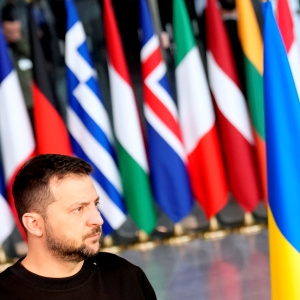Book Bag: ‘L’Allegria,’ translated by Wally Swist; ‘Listen to the Birds’ by Donald Kroodsman, Léna Mazilu and Yoann Guény
| Published: 11-22-2023 6:09 PM |
Listen to the Birds
By Donald Kroodsma, Léna Mazilu, and Yoann Guény; W.W. Norton & Co.
Donald Kroodsma, a leading expert on the science of birdsong, once taught biology at the University of Massachusetts Amherst. But the Valley writer and scientist has devoted most of the past two decades to, as he puts it on his website, “explain[ing] birdsong to general readers, not just university academics.”
Though he’s written mostly for adult audiences in titles such as “Birdsong by the Seasons: A Year of Listening to Birds,” Kroodsma has now collaborated with two people from France on a book for children, “Listen to the Birds.”
The large, hardcover title includes text by Kroodsma in which he offers short profiles of selected songbirds from eastern and western North America, from a variety of locales — forests, ponds, brush, settled areas — which are accompanied by colorful illustrations by Léna Mazilu, a French artist.
“Listen to the Birds” includes written descriptions of birdsongs, but perhaps more importantly it comes with coding that allows readers, after they download an app called “Birdie Memory,” to point a smartphone or tablet at the book’s illustrations to make the birds “sing” and even move a bit.
There are about 40 birds profiled in the book, from blue jays and robins to finches and sparrows, as well as additional information for young readers on the ins and outs of birdsong.
In an email, Kroodsma said he connected with Mazilu and Yoann Guény, a French interactive developer, after the latter two had published a similar book in France and wanted to expand to North America. The technology used in these books is known as “augmented reality,” he notes.
Article continues after...
Yesterday's Most Read Articles
 Political newcomer defeats Shores Ness for Deerfield Selectboard seat
Political newcomer defeats Shores Ness for Deerfield Selectboard seat
 Granby Bow and Gun Club says stray bullets that hit homes in Belchertown did not come from its range
Granby Bow and Gun Club says stray bullets that hit homes in Belchertown did not come from its range
 Annette Pfannebecker: Vote yes for Shores Ness and for Deerfield
Annette Pfannebecker: Vote yes for Shores Ness and for Deerfield
 Susan Tracy: Support Ukraine funding
Susan Tracy: Support Ukraine funding
 Around Amherst: Bockelman joins in launch of governor’s housing push
Around Amherst: Bockelman joins in launch of governor’s housing push
 Defying the odds: Hadley’s Owen Earle back competing less than two years removed from horrific accident
Defying the odds: Hadley’s Owen Earle back competing less than two years removed from horrific accident
L’Allegria
By Giuseppe Ungaretti
Translated by Wally Swist
Shanti Arts Publishing
Valley poet Wally Swist has been little short of prolific in the last several years, publishing a number of new collections and also penning two volumes of essays, journalism, book reviews and other prose that offered observations on the writing life and the books that most influenced him.
One writer he’s long admired is Giuseppe Ungaretti, an Italian poet and writer whose early work was influenced by his experience serving in the trenches in northern Italy during World War I.
Ungaretti would go on to become one of Italy’s most significant 20th -century literary figures. In 1931, he published “L’Allegria” (which translates roughly as “Joy”), a poetry collection that Swist first read in English translation in the 1970s.
So for his newest project, Swist has offered a fresh English translation of “L’Allegria” — the poems are also presented in the original Italian — explaining in a forward that typically in fall, he rereads work by writers he first discovered as a young man.
After deciding to reread “L’Allegria,” he checked out a copy of it from a local library, only to discover he’d taken an Italian edition by mistake. But rather than return it, he opted to do his own translation, using an Italian-English dictionary and online sources.
Though he’s translated selected works by other writers, Swist writes, his new volume represents his first full-length effort along those lines — a task he took up because he wanted to share his love of Ungaretti’s work, especially “L’Allegria,” which he says features excellent examples of the poet’s “‘cheerfulness’ in the face of adversity, and his discovery of the serene.”
It seems remarkable that the poet found reasons for cheerfulness when you consider work such as “As I Doze” (“In Dormiveglia”), which Ungaretti wrote in 1916, in the middle of WWI. It’s a short work that nevertheless offers intense images of war:
“I assist the defiled night // The air riddled / like needled lace / with bullets / some men / caught / in trenches / like snails in their shells.”
Yet in “Serenity,” which Ungaretti wrote in 1918, the poet seems to find a way to look beyond the horror of war and the squalor of the trenches to find some measure of hope and grace.
“After so much / fog / one / by one / the stars unveil / themselves // I breathe in / the coolness / of that color / the sky leaves in me. // I recognize myself / just as a passing / image // Taken on / a ride of immortality.”
Many of the poems in “L’Allegria” are short, almost like haiku, but Swist writes that such brevity doesn’t necessarily make them easy to translate. Ungaretti, he says, was a modernist who was also influenced by literary and artistic movements such as Dadaism, Hermeticism and Symbolism, lending even his short works considerable nuance.
Swist writes that he believes his translation of “L’Allegria” offers something new for Ungaretti’s poems, differing from past translations.
His key goal, he notes, has been to give readers a sense of the poet’s “sprezzatura, or ‘studied carelessness’ … but also the scintillant or crystallinity — the sparking element — that is a compelling agent in the nature of his work.”
Steve Pfarrer can be reached at spfarrer@gazettenet.com.





 A DIY approach to flying: Local pilots build and help build their own aircraft
A DIY approach to flying: Local pilots build and help build their own aircraft You’re up next: Western Mass open mic scene heats up post-pandemic
You’re up next: Western Mass open mic scene heats up post-pandemic One upon a story slam: This year’s Valley Voices winners head to a final competition
One upon a story slam: This year’s Valley Voices winners head to a final competition Preserving a key part of Emily Dickinson’s legacy: Historic Evergreens house reopens at the Emily Dickinson Museum
Preserving a key part of Emily Dickinson’s legacy: Historic Evergreens house reopens at the Emily Dickinson Museum